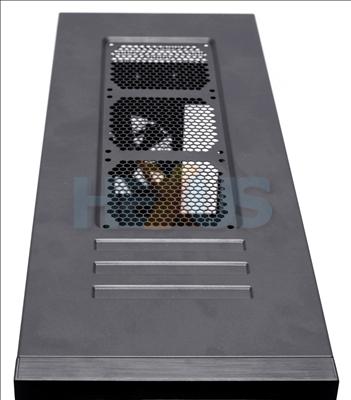Chassis tour I
Take a look at the rows of 5.25in bays and you'll be able to work out that this is one big, big chassis. Over 60cm high and 60cm deep, the minimalist black exterior - aluminium on the front - is imposing.
One easy method to differentiate the two Obsidians is to look for the hot-swap bay door on the front: the newer model is bereft of it.
The reset button is located behind the drop-down cover, together with four USB 2.0 ports, FireWire, and audio. There's still no eSATA port, and it's conspicuous by its absence. We'll leave it up to Corsair to explain why it's not included on a cutting-edge chassis aimed towards the enthusiast.
The 60cm of depth are put to good use with space for three top-mounted fans that can support triple-wide radiators often used by the watercooling crowd.
700D's main body, including top, are manufactured out of steel. An all-aluminium construction - which is perhaps the ideal - would push costs up to unpalatable levels, we reckon.
This part of the chassis is identical to the 800D. A bottom-fitting PSU makes sense, and Corsair has now rectified the problem associated with the sub-optimal fitting with certain PSUs on the first build.
A wide chassis enables Corsair to fit a 140mm exhaust fan that's pretty quiet in operation. There's provision for two rubber-covered holes for passing watercooling pipes through - handily located near the section where you'd place a radiator.
Side panels are removed wonderfully easily. Simply press on either of the two buttons at the top of the rear section and the sides become detached in an instant. The rail-mounted sides then pop back in just as easily.
The interior is arguably far more important than the exterior. Corsair's near-identical replication of the 800D means that it scores high marks here. The huge chassis has a glut of rubber-covered cutouts for easy cable routing that will lead to an aesthetically pleasing build.
Split into three cooling zone compartments, the raised chassis floor and PSU installation dictates that cooler air is pulled from the outside and exhausted out of the back. The hard-drive compartment forms the second zone, where a 140mm fan pushes air up through the drives and, eventually, out of the side and rear. The main section has the aforementioned 140mm exhaust fan and, optionally, a further three 120mm models that also exhaust heat out of the chassis.















